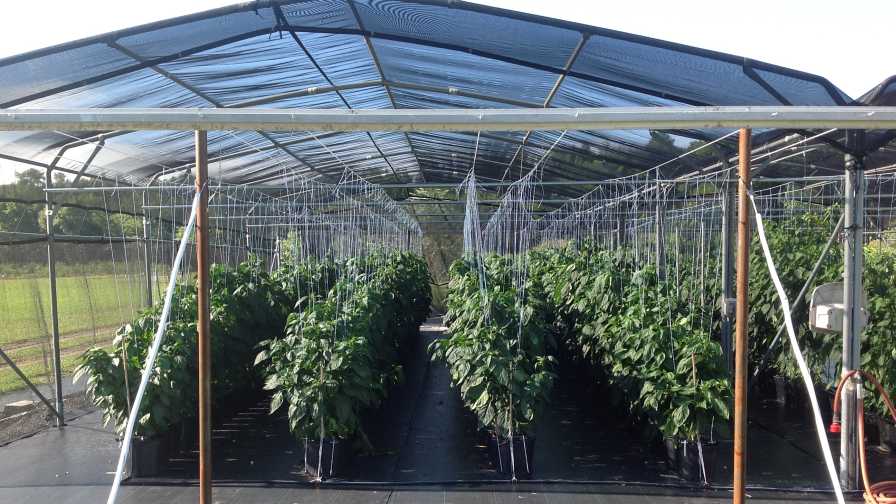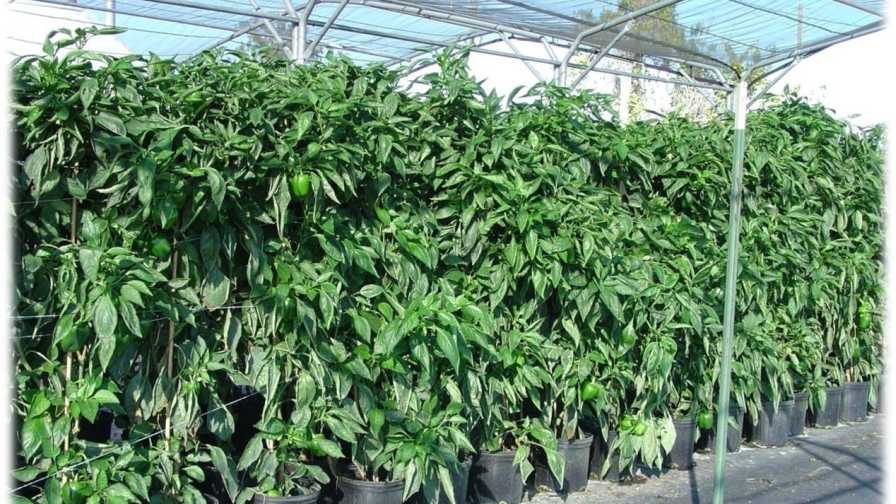How to Extend the Growing Season for Bell Peppers

A recent trial on bell peppers in Live Oak, FL, illustrated that the season could be extended using shade structures.
Photo courtesy of UF/IFAS

Green bell peppers are big business in Florida. Nearly 20,000 acres (field-grown) of the crop are planted in the state annually. Field-grown peppers are available from October to July and in abundant supply in the marketplace.
The supplies begin to fall off in the late summer and fall (July-September) due to high temperatures, high humidity, and frequent rainfall.
Small Farm Opportunity
The marketplace prefers growers consistently supply high-quality product for as long as possible. This entices large wholesale growers to produce in multiple locations to extend their season. Small, direct-market farmers also seek ways to extend the season; however, multiple locations are not generally practical. Therefore, small growers often find the adoption of season-extending cultural practices more viable.
Small growers have traditionally utilized season extension practices such as transplants, multiple varieties, row covers, plastic mulch, low tunnels, high walk-in tunnels and greenhouses. Most of these practices lengthen the season into the cooler part of the year. Yet, few practices are used to extend the season into the hottest part of the year.
Bob Hochmuth, a Regional Vegetable Extension Agent, led a trial of growing bell peppers under an open-shade structure in soilless culture to test if the system could successfully extend the growing season during hotter month. The trial was conducted at the UF/IFAS North Florida Research and Education Center-Suwannee Valley where Hochmuth serves as Assistant Director.

After eight months, the bell peppers were growing well and producing fruit.
Photo courtesy of UF/IFAS
Trial Results
Production of bell peppers in an open-shade structure resulted in mostly U.S. Fancy fruit with 3,460 boxes (28-pound boxes) per acre in comparison to 477 boxes of U.S. No. 1, 202 boxes of U.S. No. 2, and 236 boxes of culls. The yield total for U.S. Fancy and U.S. No.1 fruit was 3,937 boxes per acre. This yield is higher than yields for most open field production systems, but the growing season in the shade trial was as much as four months longer.
Large fruit was harvested throughout the season with an average fruit width of 3 inches or greater. The largest fruit width was measured during the June and July harvests at 3.5 to 3.7 inches. Fruit width decreased slightly in August and September but increased again in October and November after temperatures had cooled somewhat.
This also was noticed in the average number of fruit per box in the U.S. Fancy category during the season. Most Fancy fruit harvested during the middle of the season just made the minimum size grade for Fancy and, therefore, had many more fruit per box than the Fancy fruit during June and July.
Based on this observational trial, it appears using an open shade structure to extend the bell pepper harvest season from June to frost (November) was successful. An added benefit was that this system produced large, high-quality fruit for the entire season. Continued trialing of this system should lead to further increases in yield and quality.
* USDA Bell Pepper Grade Legend*
U.S. Fancy: Not less than 3 inches in diameter and not less than 31/2 in length
U.S. No. 1: Not less than 21/2 inches in diameter and not less than 2 1/2 in length
U.S. No. 2: Smaller sizes, but good color and quality
Structure and Planting
The open and elevated structures being trialed consisted of the following components.
- Structure: 40×40-foot, commercial shade frame made with galvanized pipe
- Shade: black 50% polypropylene cloth
- Height: The peak of the structure was 10 feet tall
- Pots: Plants were grown in 3-gallon plastic pots
- Media: 100% composted pine bark
- Spacing: Pots were arranged in double rows with 5-foot spacing. Plants were spaced 18 inches apart in the row.
- Planting Date: April 1 (6-week old ‘Heritage VR’ transplants)
- Irrigation and Fertilizer: Plants were watered and fertilized with a hydroponic solution several times daily.
- Stakes: Plants were supported by 5-foot bamboo poles, which were tied with string and anchored by a metal fence post driven into the ground between rows.
- Harvest: Mature green fruit were harvested every seven to 14 days from June 16 through Nov. 9.
EDITOR’S NOTE: This story is a summary of an UF/IFAS study titled: “Growing Bell Peppers in Soilless Culture Under Open-Shade Structures.”










